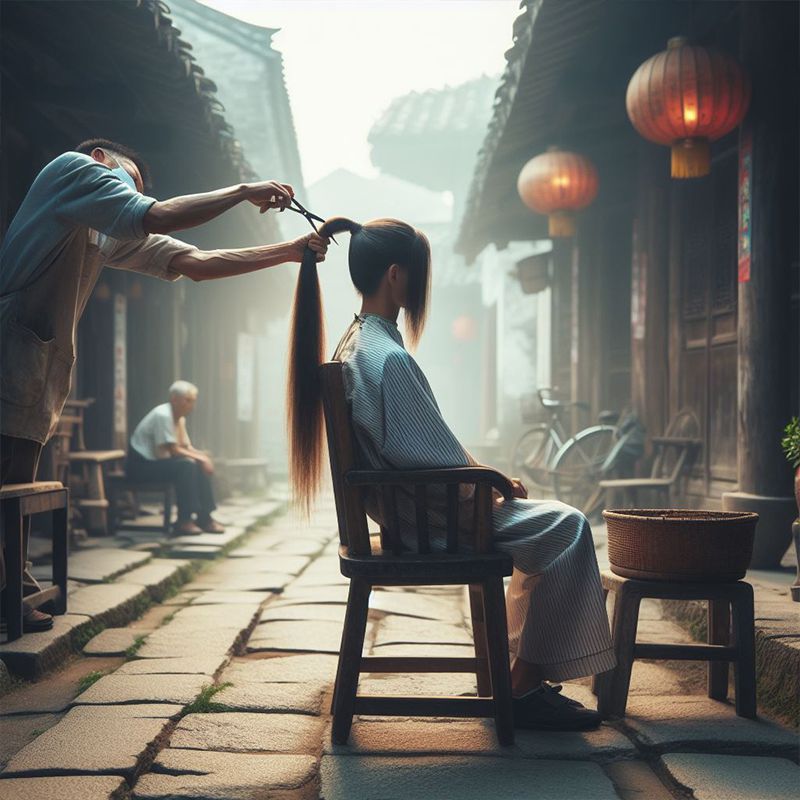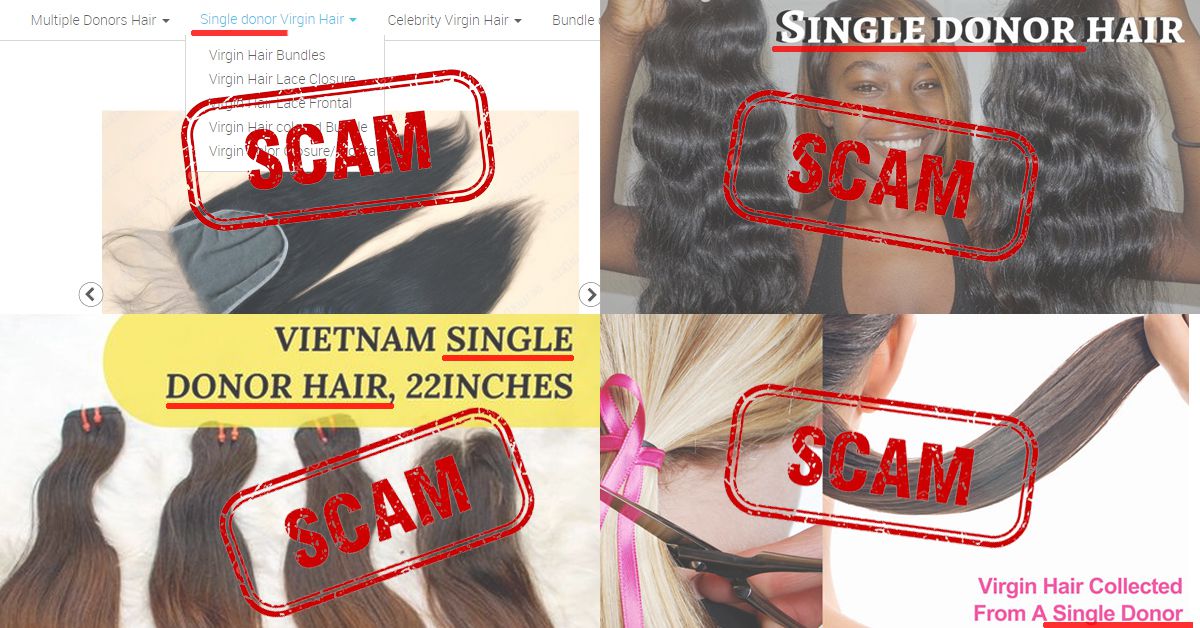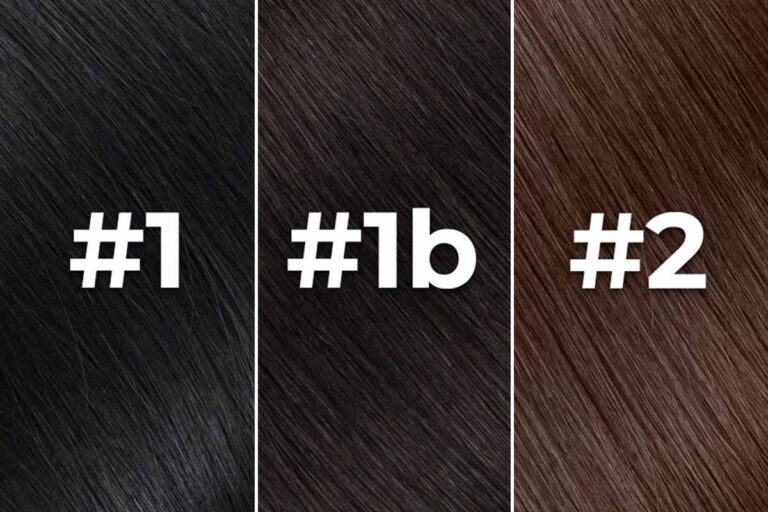The Single Donor Hair Scam
Many new clients are looking for the best quality and request SINGLE DONOR raw hair. They do not realize that they end up wasting their time and money looking for a vendor who is lying to them. Single Donor Hair is simply a silly marketing label, and it doesn’t make sense when you think about it logically.

Table of Contents
What is single donor hair?
Hair that comes from one donor is called single donor hair. This type of hair is exactly what it sounds like: hair cut from one person’s head and then donated. Even though it’s called single-donor hair, most single-donor hair is sourced from multiple donors. This means it’s simply a label attached to a product to make it sound better and more luxurious than what you’ll actually get.
Is multi-donor hair lower quality than single donor hair?
Let’s imagine you buy three single-donor bundles and a single donor frontal from your vendor. You go to your stylist and have them installed. How many donors are there in your hair? The answer is four. Some people think that using four different donors must be less quality than using a single donor. But this is not true! You can use multiple donors without sacrificing quality if you have good-quality hair from the start.
Can you tell the difference between multi- and single donor hair extensions?
When we take a closer look at how things are done on an industrial scale, it becomes clear how easy it is for companies to pass off multiple-donor hair as single-donor. It’s impossible to differentiate between a bundle from a single donor and one from three donors. You can test for synthetic fillers, check if the hair has been colored, or test if the hair has been chemically processed. However, if the hair has been mixed and matched correctly, there isn’t a test you could do to tell the difference between the number of donors. (Unless, of course, you’re a forensic scientist!)

Production of single-donor hair extensions
Single-donor hair is actually quite difficult to produce. Let me give you a few examples:
Weight of the donor’s hair
Hair from a donor will not come in perfect 100-gram bundles if you cut it. Some will weigh more, while others will weigh less. A bundle can no longer be used to create single donor hair if it weighs more than 90 grams. So, what do you think the manufacturers will do? Discard it and resell it as multi-donor hair at a lower price? Add some hair from another donor and sell it at a higher price as “single donor hair?” You can guess what they do because mixing and matching does not affect quality.
Making the decision to sell one’s long hair can be a challenging one. It can significantly alter one’s appearance, which is why many women choose not to sell their hair. As a result, hair collectors often only cut a few deeper layers of hair. This technique thins out the hair while still preserving a full appearance. So, hair collectors might only collect around 30 grams of hair at a time, making it quite unlikely that you’re getting anything single-donor.
Producing the wefts
Some YouTube videos show how the wefts are created. They usually use a triple sewing machine system, with a worker feeding bulk hair at the beginning. The employee does not simply feed 100 grams of hair, complete the weft, and then cut it to weight. Instead, they make a very long weft, which is then weighted and finished. The fed bulk hair for raw hair extensions will come from various donors. Using a single donor hair would complicate the process.

The ratio of short to long Hair
When you buy ten bundles from a vendor, they will almost certainly all be the same fullness. You’ve seen about 10-12% full of single-drawn bundles from China. This means that only 10-12% of the hair in the bundles is the full length. Vietnamese claim to sell hair with up to 80% fullness, but I’m not convinced. However, it still demonstrates that they control how full the bundles are. This practice should be standard practice in India as well. So, if they include some short, medium, and long lengths, will they all come from the same donor? Obviously not.
Why would manufacturers go through the trouble of producing single-donor hair if it’s that difficult? It complicates the manufacturing process, but it has no effect on quality, and no one can tell the difference. What is the purpose of creating single-donor hair? The answer is simple: they’re deceiving you. People believe them and are willing to pay more money to them.
Where does the quality difference come from?
Only about 10% of the hair on the market is cut from a donor and has aligned cuticles. That means the other 90% is floor hair. Floor hair comes from various donors and does not have cuticles that point in the same direction. This is why it must be processed. To prevent tangling, the hair is usually processed by soaking it in an acid bath to burn some of the cuticles off. This is what reduces the quality of the hair, as well as its lifespan and bleachability.
This means that the quality difference is determined by whether the hair was cut directly from a donor or was floor hair, rather than the number of donors. If you’d like to learn more, read this article.
False marketing outsells honesty
Vendors don’t want to admit that their hair is chemically processed, as it makes bad marketing. If there are two vendors selling the exact same processed hair, one calls it “Virgin Hair”, and another “Chemically Processed Floor Hair”, who’s going to get more sales? The dishonest one. While there are people who understand what honesty means and prefer to go with the honest vendor, marketing plays an important role in sales.
Follow us on YouTube, Facebook & Instagram for more about us, our articles, and our products.
What is single-donor hair?
Single-donor hair is marketed as hair sourced from one individual. However, in reality, most “single donor” hair is sourced from multiple donors, making it more of a marketing label than an accurate descriptor of the product.
Can you tell the difference between multi- and single donor raw hair extensions?
It’s challenging to differentiate between hair extensions from single and multiple donors. Industrial processes make it easy for companies to pass off multi-donor hair as single donor, making it difficult for consumers to discern the difference. It’s only noticeable when the number of donors per bundle reaches a dozen.
Where does the quality difference come from?
The quality difference in hair extensions arises from whether the hair is directly cut from a donor or sourced as “floor hair” from various donors. Floor hair requires processing, such as soaking in an acid bath, which reduces its quality, lifespan, and bleachability. Poorly sourced hair does so as well.
How can I ensure honesty in the hair market?
It’s essential to raise awareness about deceptive practices in the hair industry and educate consumers about the true factors that determine hair quality. By promoting honesty and transparency, we can foster a more trustworthy market environment.







Very informative! Especially for someone new to the hair world. Thank you
Thank you for your feedback, much appreciated!